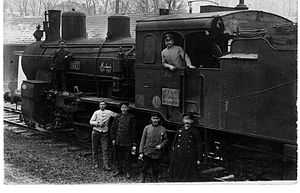Bavarian C VI
| Bavarian C VI and G 3/4 N DRG Classes 54.13 und 54.14 | ||
|---|---|---|
 Bavarian C VI with state railway No. 1627. Photographed on 10 January 1917 in Montmedy, France | ||
| C VI | G 3/4 N | |
| Numbering: | 1551–1633 post 1918: DRG 54 1301–1364 PKP Ti101-1 to 7 Etat Belge 7379…7391 ČSD 334.601 |
1634–1670 post 1918: DRG 54 1401–1432 PKP Ti101-8 to 9 Etat Belge 7372…7393 ČSD 334.602 |
| Anzahl: | 83 | 37 |
| Manufacturer: | Krauss, Maffei | Krauss |
| Built: | 1899–1905 | 1907–1909 |
| Retired: | by 1935 | by 1934 |
| Wheel arrangement: | 2-6-0 | |
| Axle arrangement: | 1'C n2v | |
| Rail gauge: | 1435 mm | |
| Length over buffers: | 17435 mm | 17457 mm |
| Wheelbase incl. tender: | 14570 mm | |
| Service weight: | 55.2 t | 55.8 t |
| Adhesive weight: | 42.6 t | 43.2 t |
| Axle load: | 14.2 t | 14.4 t |
| Top speed: | 60 km/h | |
| Driving wheel diameter: | 1340 mm | |
| Leading wheel diameter: | 1006 mm | |
| Valve gear: | Walschaerts (Heusinger), outside | |
| No. of cylinders: | 2 | |
| Cylinder bore: | 500/740 mm | |
| Piston stroke: | 630 mm | |
| Boiler overpressure: | 13 kg/cm² = 12.75 bar | |
| Grate area: | 2.25 m² | |
| Evaporative heating area: | 133.2 m² | |
| Tender: | bay 2'2' T 18 | |
| Tender service weight: | 45.3 t | |
| Water capacity: | 18.0 m³ | |
| Fuel capacity: | 6.5 t coal | |
The goods train locomotives of Class C VI were German steam engines built between 1899 and 1905 for the Royal Bavarian State Railways (Königlich Bayerische Staatsbahn). It had great similarity to the Prussian G 5.4, but had a higher boiler overpressure and better riding qualities. In all the Bavarian state railways procured 83 engines of this type over that period. More machines with slight modifications were acquired between 1907 and 1909. These 37 engines were given the designation G 3/4 N. The Deutsche Reichsbahn inherited 64 Class C VI and 32 Class G 3/4 N engines. These were given operating numbers 54 1301–1364 and 54 1401–1432. The Class C VII locomotives remained in service until 1931, their Class G 3/4 N sister locomotives until 1935.
Both variants were equipped with a Bavarian 2'2' T 18 tender.
See also
External links
- There is a relevant English-language forum at Railways of Germany
| |||||||||||||||||||||||||||||||||||||||||||||